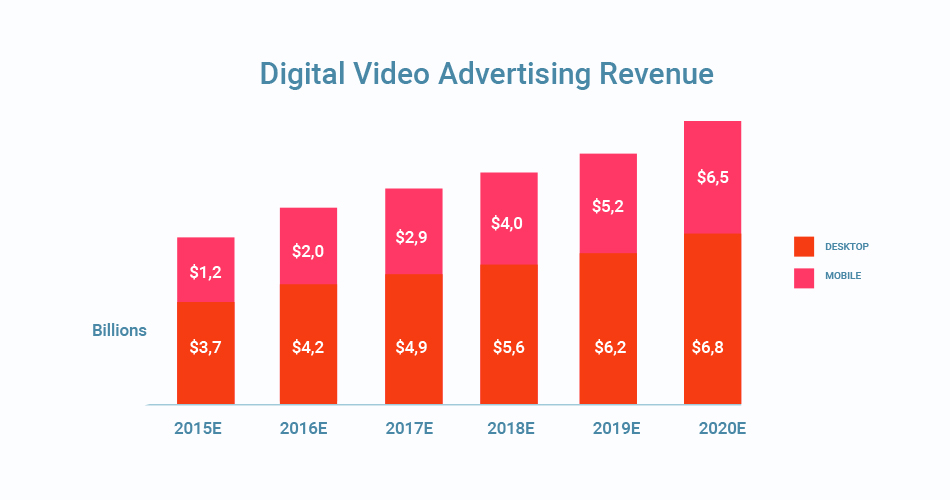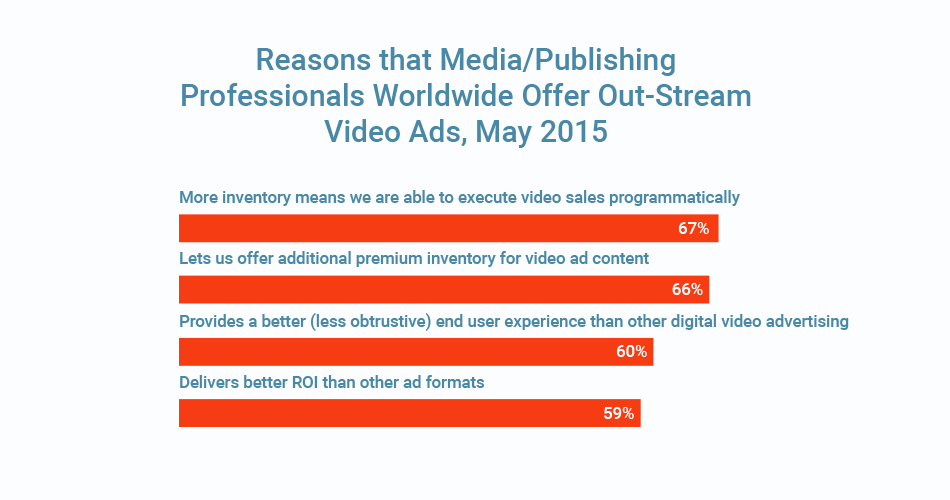Outstream video advertising, also referred to as “in-read” or “native video,” has been making waves in online digital marketing for a few years as an alternative to the widespread and still very popular In-stream video ads.
If you haven’t explored this avenue yet and have been wondering whether Outstream ads are a good option for your business, you’re in the right place. Here’s everything you need to know about this game-changing video advertising format.
Why are Outstream ads relevant in today’s consumer market?
Intrusive advertising turns people off. Surprised? We’re not!
Outstream ads are a great way to implement advertising that blends in. They’re both less intrusive and more engaging because they are integrated into (“in-read”) and contextually more relevant (“native”) to the webpage and content being viewed. And while they can also be played on YouTube, according to Google, “Outstream ads drive incremental, cost-efficient, and viewable reach beyond YouTube.”
We’re going to talk about how and why Outstream ads work shortly. First things first: How are In-stream and Outstream ads different?
What are Outstream ads, exactly?
Let’s start with a brief review of In-stream ads, so we can see how Outstream ads differ. It’s important to know that In-stream ads take a couple different forms, including a video ad that can be played before (“pre-roll”), in the middle of (“mid-roll”), or after (“post-roll”) the main video content. You may also see them as clickable banner overlays floating above the video content.
In-stream ads
- Require existing video content. In-stream ads must be paired with existing video content as part of a static player. This can be a problem for publishers without video streaming capabilities.
- Consumers find them intrusive. If you use YouTube, you likely know that “pre-roll,” “mid-roll,” and banner overlays are designed to be forced on the watcher or at least somewhat in-your-face, which many consumers find frustrating and intrusive because they have to manually click out, skip, or wait for the ad to finish.
- Difficult to optimize. An inherent weakness of In-stream ads is that, since they are inserted into existing video content, they tend not to be well-matched or relevant to this content.
There is no such missed opportunity when it comes to Outstream ads. Here are some of their main points and features:
Outstream ads
- The ad is the content. Outstream video differs from In-stream because readers are not expecting the post-ad video content, making the ad the main feature. No existing video content? No fear. FatChilli provide the video content and player tech, saving you time and resources. This possibility makes life easier for publishers because the video player and video content (that must follow the ad) come two for one.
- Designed to be unobtrusive. When a user reaches a “trigger point” of a page where an Outstream ad is hidden, often between specific paragraphs of text, the video will expand to form a video player. It appears when the viewer reaches the trigger point and disappears either when the video finishes or the viewer scrolls away.
- Easily matched for higher contextual relevance. Outstream ads have a more natural or “native” feel both because they blend in with the published content and because they lend themselves to easy matching with related content. You can choose the location of the ads’ trigger points so that they are integrated with, and relevant to, what comes before and after.
To help you visualize it, see this successful example from an early test for the Hong Kong tourism board. Google found that “Outstream video ads delivered strong results for our global brand campaign: 30% incremental reach with a 40% lower cost per completed video view and 85% lower CPM.”
How do Outstream videos work?
Outstream videos are a video player and video content rolled into one, meaning both load at the same time. The ads work with trigger points embedded between text or other pieces of content.
As a user scrolls through your webpage, they will reach a hidden page break that triggers the video. The ad will appear as the video expands. From here, a few different things can happen:
- The user watches the video to the end, and the ad will disappear between the previous text, banner block or content.
- The user scrolls away to where the ad is still visible but less than 50% viewable, and the video pauses.
- The user scrolls away completely and the video disappears, waiting to be triggered if and when the user navigates back to the area.
Outstream ads provide an alternative to the skippable/nonskippable conundrum, whereby nonskippable ads often result in viewer frustration or closing of a webpage and allowing an ad to be skipped results in low watchthrough rates. In the case of Outstream, the video and player are pre-loaded, and can resume any time the user reaches the trigger point.
What are the main benefits of Outstream?
Outstream ads are highly viewable and unintrusive.
The future is mobile. Some statistics find that consumers now spend more than 2x of their time on mobile rather than desktop devices. And according to Teads, “60% of brands increasing their digital investment agree outstream is better optimized for mobile than instream video ads.”

Outstream ads are spatially economical because they are hidden until triggered. Plus, you don’t need to have video player capability. Outstream ads are a self-contained video and player all in one.
Outstream ads provide impressive UX.
This self-contained nature means faster load times and better customer experience. Plus, you have the opportunity to insert the most relevant ads into text and other content without worrying, as with In-stream ads, that consumers will skip or navigate off the webpage. Since Outstream doesn’t obscure or delay the main content, it doesn’t cause the same frustrations as In-stream.
Outstream ads are engaging and effective.
Outstream ads provide a fantastic value with higher eCPMs than In-stream ads.
Brand professionals report higher brand awareness, conversion rates, and consumer reach with Outstream ads in comparison with In-stream ads. Plus, it’s easy to engage the user to create conversions by clicking the ad to see more.

Why should publishers use Outstream ads?
Advertisers spend more of their budgets on video ads each year, which has resulted in higher revenues. However, Outstream ads come without the extra expense of needing pre-existing video content, as In-stream ads do.

Outstream ads compare favorably to In-stream ads for a few reasons. They load faster and are less intrusive. Viewers of In-stream ads often watch numbly, waiting for their ability to skip or the ad to end. In contrast, consumers exposed to Outstream ads were found to be more aware of the brand afterwards.
According to eMarketer, 60% of advertisers agreed that Outstream ads provide a better (less intrusive) end-user experience that other forms, and 59% agreed that it delivers better ROI.

Which Outstream methods are ideal for publishers?
Outstream ads can appear fixed at the bottom of a page, on top of a picture or slide-in, or they can reside natively within text content. It’s your choice!
Best Outstream methods for mobile web: native, in-feed, sticky
Best Outstream methods for mobile app inventory: native, rewarded video, interstitial, in-feed
Best Outstream methods for desktop: native, sticky (recommended)
Our dedicated team at fatchilli.media offers the following most popular formats: In-Text, In-Banner, and Sticky. See a live demo here for yourself!
Ready to try Outstream video?
Outstream may be a newer kid on the block, but it’s fashion-forward and has the potential for big gains. Plus, it’s extremely easy to set up. There’s only a small amount of code needed to generate video ads on your site.
If you’re interested in Outstream, we invite you to try our 14-day, risk-free trial now!


 Slovenčina
Slovenčina 


